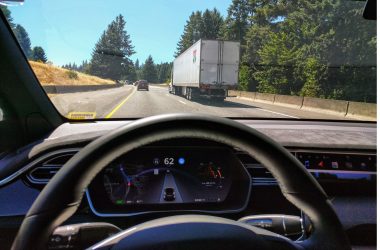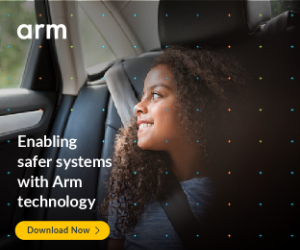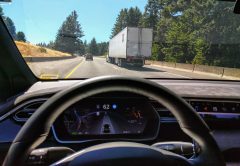Peter Rössger, founder of beyond HMI/////, led a World Café session at the Car HMI Europe 2018 on HMI in autonomous vehicles to detect the real need for innovation. The World Café was split into 5 sessions of 30 min each. In each of the sessions different attendees where present. Information was collected in two rounds of brain storming. In the first round problems and issues where recorded and discussed. In a second round solutions where searched. Each session was finalized by marking three key take-aways.
Autonomous Driving Level 2
Autonomous driving on level 2 is defined as driving with longitudinal and lateral control performed by the vehicle. The driver shall remain in the loop constantly to control the driving procedure of the vehicle.
The main issue identified was the mode awareness. Drivers need to know exactly how is responsible for what. If an action by the driver is required, the vehicle needs to indicate that clearly. Today’s solutions with comparably small indications like icons on the dashboard are not sufficient.
A second issue discussed is trust. The driver may overtrust the vehicle, which means that actions are not taken in an appropriate way. The driver trusts the competence of the vehicle more than technology can realize. Distrust or mistrust hinder the use of technology. Driver don’t trust the vehicle and just don’t turn the systems on. Drivers will pull themselves out of the loop unintentionally. Humans are not very good in controlling systems working. The so-called captain’s mode shall be avoided. The constant control of the vehicle does not gain peace of mind for the driver.
The system needs to communicate the status (autonomous vs. manual) clearly and multimodal. This includes clear indications on displays. To strengthen the signal only relevant information shall be given. Signals and handover procedures shall be standardized in the automotive industry. The driver needs to be controlled by the system. Moments of inattention will be detected. The driver will be pulled back into the driving loop.
The key take-aways were:
Autonomous Driving Level 3
On level 3 the autonomous vehicle takes over lateral and longitudinal control. The level of autonomy allows the driver to step out of the continuous driving loop. He may take other activities like reading, communication, or playing games. The driver shall be back into the driving loop when required in a short time frame. Discussions in the automotive industry indicate, short time means 3 to 4 seconds in this context.
Main issues on level three are the design of the hand over procedure, the communication of limits of the system, and the unpredictability of the handover requests. The machine needs to get the attention of the driver quickly and communicate the overall situation to create a sufficient situation awareness. The driver shall be forced to keep an eye on the road to avoid surprises. The handover times are too short. Level 3 does not allow real relaxation of the driver.
Solutions for these issues include an extension of the handover times, multi-modal handovers like vibrations in the seat, acoustic, haptic, and olfactory signals. The name of the driver shall be used to grab attention. Reasons for the machine failure need to be communicated.
Morphing and transparent materials support the procedure. Feedback on the level of attention required shall be provided. This will lead to HMI solutions that do not only have driver or machine statuses, but soft handovers with fading responsibilities. An emergency button to stop the vehicle needs to be implemented in any autonomous car.
The key take-aways were:
Autonomous Driving Level 4
On level 4 the autonomous vehicle takes over lateral and longitudinal control and is driving in most driving situations. The level of autonomy allows the driver to step out of the continuous driving loop for a longer time. He may take other activities like reading, communication, or playing games. The driver shall be back into the driving loop in a few minutes.
Drivers will experience a loss in competence. The vehicle will drive autonomously for longer time frames. An interaction with the driver concerning the core driving task will not be required in well designed and controlled environments. When a critical situation occurs, and the driver needs to take over, the driving competence may not be sufficient anymore. Further-on the consequences of a failure to comply and take over are not clearly communicated. Guidance and recommendations may not be given properly.
Drivers shall be forced into manual driving, for example 30 minutes per week. Driving skills are recorded and detailed feedback is given. This may include comparisons in gain or loss in skills over time and comparisons with other drivers. Further training sessions may be performed.
The transition process will be supported by giving the driver the appropriate amount of context. Driver are forced into the correct driving position after long times of relaxed seating positions. The driver shall be kept engaged with the vehicle by solving additional tasks, like interacting with the navigation device or driving performance related social networks. The limits of autonomous driving shall be indicated to the driver.
The key take-aways were:
Autonomous Driving Level 5
Level 5 autonomous driving is fully autonomous driving. The core driving process is controlled in any situation at any time by the machine. We will have driving robots. Passengers in such vehicles are free to perform any activity inside the vehicle.
The main issues discussed where, if a level 5 car is still a car, of if it is a rolling living rom. Or like a public transport train. User will experience fears on driving quality, correct routing, breaks and more. We may experience parking lots full of cars with sleeping passengers. Users will emotionally detach from the car, brands will lose their importance. Users will not be able to personalizes their vehicles. How can users enter the destination into the vehicle? If level 5 cars will transport more than one person and they are strangers, how can social frictions be solved?
Level 5 cars can offer a totally new kind of travel experience, make it a holistic experience including before, during and after the travel into one experience. User shall have the possibility to fine tune the driving style of the car. Personalization should be possible for every passenger. Trust will be built by avatars or virtual chauffeurs, that interact with the user. The freedom of move will include intermodal traffic. OEMs will change from offering vehicles to offering transportation experiences. Support will be given by external operators, that create trust and safety. HMIs will show routes, speed, destinations and other information to grow trust.
The key take-aways were:
The full World Café report including all insights is available for download. It also contains the participants’ ideas and inspirations about how potential level 6 automation could look like in the future.
Please click the download button below to access your report:











